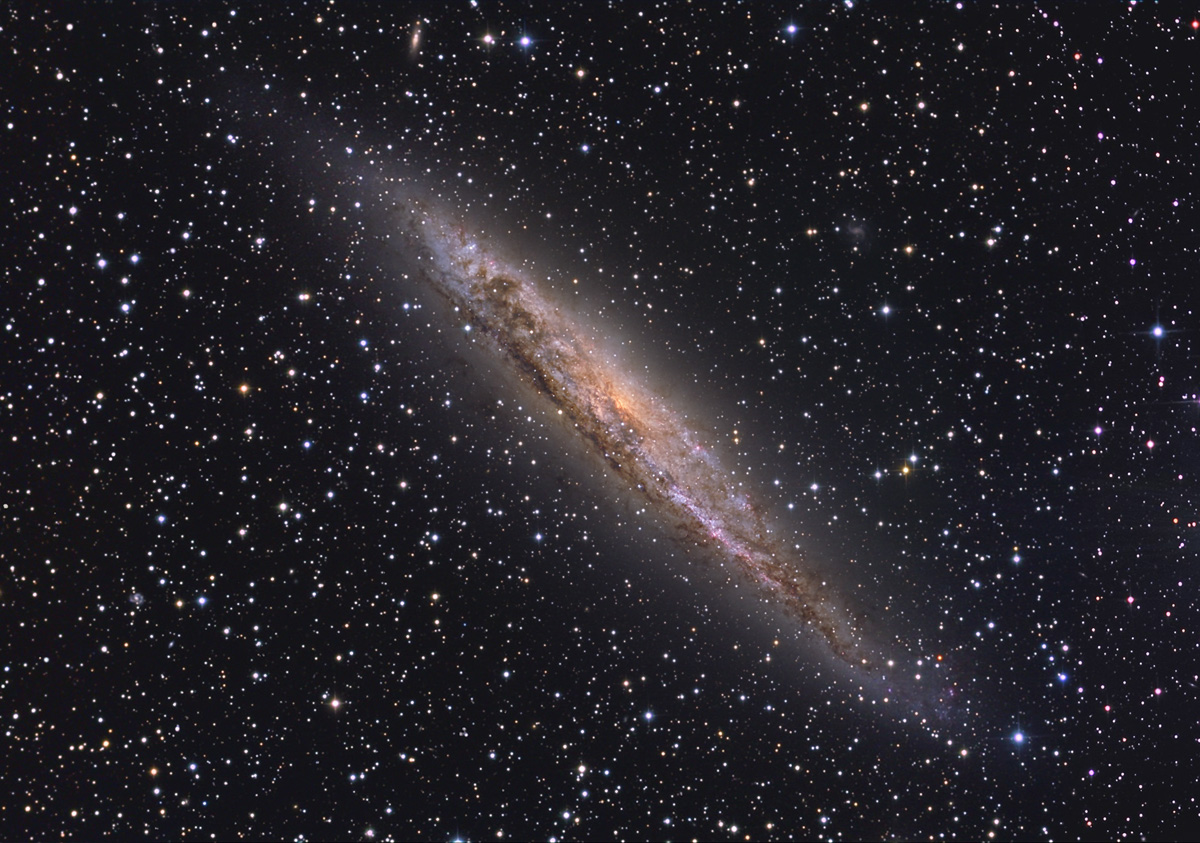
[back] NGC 4945 with SN2005af in Centaurus [NED]
Higher resolved image / höher aufgelöstes Bild

|
Type SBc, distance ~ 2.7Mpc/8.8MLy. |
|
2' |
|
(c) 2006 All astro photo images are copyrighted. They may not be used or reproduced without explicit written permission from the authors.
About this Image / Über dieses Bild
|
CCD: |
ST10 XME |
|
Image Type, Orientation: |
L(R+Ha)GB,North is at 12:00h. |
|
Exposure time: |
L: 12x300s 1x1 bin, R,Ha,G,B: 4x300 sec. each, 2x2 bin |
|
Exposure date: |
May 10th, 2005 |
|
Location: |
Capella Observatory at Amani Lodge, Kupferberg near Windhoek, Namibia |
|
Filter: |
FR03 + Astronomik |
|
Instrument: |
Ganymed 60cm-Hypergraph in primary focus (f=1800 mm) |
|
Image seeing (FWHM): |
2.5" |
|
Photographer: |
Josef Pöpsel, Beate Behle |
|
Remarks: |
The distance of NGC 4945 to the Milky Way is only four times bigger than the distance of the Andromeda galaxy. But because we look nearly edge on and the galaxy is sorrounded by a huge amount of dust, even under the darkest southern sky the galaxy can not be seen with naked eyes. Comparing the image with one done by ESO (see here) the redish star at the lower right "end" of the galaxy got our attraction - it could not be found on the ESO image. Some internet research solved the mystery: the star is SN2005af (SN Type II), which was discovered about three month before the date of exposure and probably exploded midd of January 2005. In the higher resolved image SN2005af looks more unsharp than the foreground stars. We assume the reason is the very redish spectrum of the SN, which results in a not perfect focus due to the corrector lenses of Ganymed's primary focus and the slightly different optical length of the Ha-filter compared to the other filters. |
|
Bemerkungen: |
NGC 4945 ist nur vier mal soweit von der Milchstraße entfernt wie die Andromeda-Galaxie. Da wir aber einerseits nahezu direkt auf die Kante sehen und die Galaxie andererseits von immensen Staubmassen umgeben ist, ist sie auch unter dunkelstem südlichen Himmel nicht mit bloßem Auge auszumachen. Beim Vergleich mit einer Aufnahme der ESO (siehe hier) fiel uns der rötliche Stern nahe dem unteren rechten "Ende" der Galaxie auf, der auf der ESO-Aufnahme nicht zu sehen war. Einiges Wühlen im Internet brachte Aufklärung: es handelt sich um die Supernova SN2005af (SN Typ II), die ca. drei Monate vor dem Aufnahmezeitpunkt entdeckt wurde und wahrscheinlich Mitte Januar 2005 explodiert ist. Wie in der vollen Auflösung zu sehen ist, ist SN2005af deutlich unschärfer als die Vordergrund-Sterne. Wir vermuten die Ursache im sehr niederfrequenten (roten) Spektrum, das aufgrund der Korrektorlinsen von Ganymeds Primärfokus und der im Vergleich zu den anderen Filtern etwas unterschiedlichen optischen Länge des Ha-Filters zu einer unscharfen Abbildung führte. |
Back to the Galaxies' Overview / Zurück zur Galaxien-Übersichtsseite